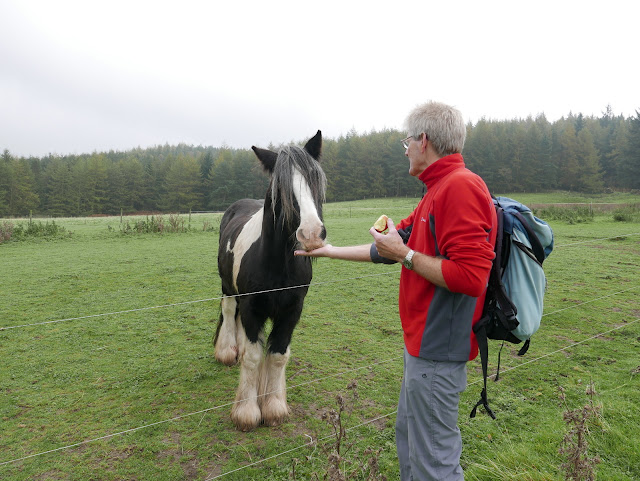Kildale to Baysdale and its Lost Abbey
9 miles Cloud with rain later
We parked at the side of the road in Kildale and left the village towards Little Kildale.
 |
| Today's walk from The Walker's Guide to the Cleveland Hills |
 |
| Setting off through Kildale |
 |
| The Old School House, Kildale |
 |
| The Lodge, Kildale |
Tom Scott Burns informs us that Kildale is a village of great antiquity. There are several 'Kildals' in Norway and the village was probably named by the Vikings. It was called Childale in the Domesday Book. In 1156, where the church now stands, was a wooden castle built by the Percys, Earls of Northumberland. Walking through the village we turned off the road towards Little Kildale and passed through a couple of sheep fields before reaching Little Kildale Wood and then carried on to Warren Farm.
 |
| Looking towards Little Kildale |
 |
| Little Kildale |
 |
| New pigeon weather vane at Little Kildale |
Following our path past Warren Farm through a field of horses and donkeys, we came to a large square chimney as we descended to Leven Vale. This is the remains of an ironstone mine that was operational between 1866 and 1874. Crossing the River Leven, whose source was just to our right, we started a climb up through meadows towards Kildale Moor.
 |
| Gate near Warren Farm |
 |
| Horses and donkeys at Warren Farm |
 |
| "Well they were friendly enough..!" |
 |
| Old Ironstone Mine |
 |
| The source of the River Leven |
We now climbed steadily to Kildale Moor and having reached the top at 900 feet, we descended towards Baysdale Beck, soon reaching the remains of an old barn where our path turned sharp left.
 |
| The moor gate on Kildale Moor |
 |
| Old buildings near to Baysdale Beck |
 |
| We turned left on reaching this building |
The track, which runs parallel to Baysdale Beck, is an old lime road that enabled limestone to be carried from Commondale into Cleveland, and we followed this for 1.5 miles until we reached a tarmac road.
We turned right onto the tarmac road and walked steeply downhill to pretty Hob Hole, where we sat on a couple of boulders to enjoy our coffee and scones.
 |
| Descending steeply to Hob Hole |
 |
| Hob Hole |
 |
| We sat on the rocks on the right to enjoy our coffee |
 |
| Baysdale Beck at Hob Hole |
Hob Hole was supposed to be the haunt of a mischievous hobgoblin who taunted weary travellers and TSB reports a Canon Atkinson speaking of Padfoot, "Padfoot, a precursor of death; sometimes visible, sometimes invisible, but ever and anon padding lightly in the rear of people, then again before them or at their side, and uttering a roar unlike the voice of any known animal."
Fortunately there was no sign of Padfoot today and we ate our scones in peace before crossing the ford and heading steeply up the tarmac road, then turning right into John Breckon Road. As we walked along this narrow road we had views through the mist towards Westerdale.
 |
| Looking back to the water splash at Hob Hole |
 |
| Climbing John Breckon Road |
 |
| Westerdale |
 |
| Turn right onto the moor |
After half a mile or so we turned off John Breckon Road to folow a heather track that returned us back along the opposite side of Baysdale Beck, passing a memorial to Alan Clegg 'Who loved these moors'. We arrived at Great Hograh Beck where there is a small stone footbridge and a wooden memorial seat.
TSB notes that the footbridge was built in 1938, according to an inscription, and was the work of Rowland Close, of nearby Low House Farm.
 |
| Returning over the moor on a parallel track |
 |
| "Alan Clegg, who loved these moors" |
 |
| Memorial seat at Great Hograh Beck |
 |
| Bridge built by Rowland Close |
Shortly after the stone bridge we turned right onto a wide track and followed the path across the moor. We walked downhill and passed by the above mentioned Low House Farm where Clive fed apples to a horse and a couple of Shetland ponies.
 |
| Leaving the moor |
 |
| The Low House |
 |
| Making a friend |
 |
| We were fascinated by the horse's curly moustache! |
 |
| Shetland Ponies |
We passed through Thorntree House Farm before reaching the Abbey.
The original abbey was occupied by 9 or 10 nuns from 1190 to 1539. TSB tells how in 1304 Prioress Joan de Percy had not adhered to the monastic rules and Archbishop Corbridge had to commit the custody of the nuns of Baysdale to Roger de Kellshay, rector of Crathorne. By 1307 Joan remained disobedient and was deprived of her post. She absconded from the abbey with some other nuns and Archbishop Grenfield ordered them back to the abbey "that they return without delay and not go outside the precincts of the abbey and serve God under the yoke of obedience..." Unfortunately TSB doesn't relate how the story ends, did Joan continue with her wild ways or submit to the yoke of obedience? NB See below

















































No comments:
Post a Comment